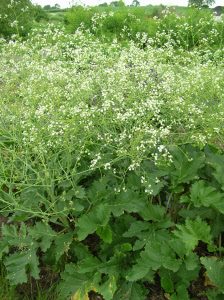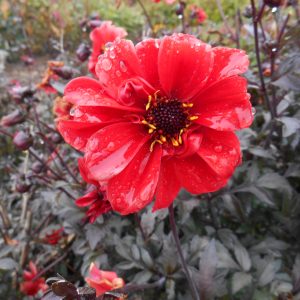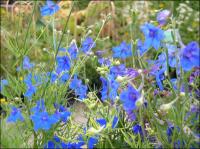Archives
Showing 57–64 of 199 results
-
Crambe cordifolia Colewort Z. 5-9
Giant profusion of white flowers from late May to June
ARCHIVED
Note: This is a plant not currently for sale. This is an archive page preserved for informational use.
Giant profusion of white flowers from late May to June
Size: 7-8’ x 5’
Care: full sun in well-drained soil
Native: CaucasusFirst collected before 1863. ”This is a stately and noble plant, with large heart shaped leaves. The loose flower-heads, which are often 6 feet in height, and nearly as much through, are composed of myriads of small white flowers, which at a distance may be likened to a giant specimen of Gypsophila; it blooms during June and July.” H.H. Thomas 1915.
-
Cryptotaenia japonica ‘Atropurpurea’ Purple-leaved Japanese Wild Parsley, Japanese honeywort Z 4-7
Flowers light pink small umbels in mid-summer but forget the flowers and grow this for its showy purple bronze stems and leaves, branched stems with deeply divided, compound leaves and slightly ruffled
ARCHIVED
Note: This is a plant not currently for sale. This is an archive page preserved for informational use.
Flowers light pink small umbels in mid-summer but forget the flowers and grow this for its showy purple bronze stems and leaves, branched stems with deeply divided, compound leaves and slightly ruffled edges
Size: 18-24" x 8" and self-seeds to make clumps
Care: sun to part shade in moist to moist well-drained soil
Native: eastern Asia1st described in Journal of Japanese Botany in 1926. Asians use Honeywort as a seasoning, a strengthening tonic and eat its sprouts in salads but toxic if eaten in large quantities.
CAUTION: may cause dermatitis with repeated contact in some people; toxic if eaten in large quantities. -
Cynara cardunculus Cardoon Z 7-9
Spectacular basal foliage - arching, silvery, deeply incised leaves, Late summer-fall spiny buds open to rich purple feathery flowers.
ARCHIVED
Note: This is a plant not currently for sale. This is an archive page preserved for informational use.
In colder areas grow as annual
Spectacular basal foliage – arching, silvery, deeply incised leaves. Late summer-fall spiny buds open to rich purple feathery flowers.Size: 3-4’ x 3-4’
Care: sun in moist well-drained to well-drained soil. Cut off flowers immediately after flowering to bring on new foliage, gorgeous into late fall.
Native: Southern EuropeThe leaf stems, blanched, are also edible. Bridgemen, The Young Gardeners Assistant (1847)
Described by Linneaus 1753. -
Dahlia ‘Bishop of Llandaff’ Tender perennial
Fiery red, sem-double flowers atop reliably purple foliage from July until frost,
ARCHIVED
Note: This is a plant not currently for sale. This is an archive page preserved for informational use.
Fiery red, semi-double flowers atop reliably purple foliage from July until frost
Size: 2-3’ x 12”
Care: moist well drained soil in full sun – lift bulb in fall, overwinter in basement
Awards: Royal Horticultural Society Award of Merit – 1928.Dahlias originally grown as food by Aztecs. 1st collected for the West by Spaniards in Mexico in 1615. The genus named after Dr. Anders Dahl, a student of Linnaeus and later a Swedish botanist in his own right. This cultivar came from a batch of chance seedlings in the nursery of breeder Fred Treseder in Wales UK. Treseder offered this and a few others to Bishop Joshua Hughes of Llandaff in 1924.
-
Dalea aurea syn Parosela aurea Golden prairie clover Z 5-9
Cone-shaped fuzzy yellow flower spikes rise above sparse foliage in April-June
ARCHIVED
Note: This is a plant not currently for sale. This is an archive page preserved for informational use.
Cone-shaped fuzzy yellow flower spikes rise above sparse foliage in April-June
Size: 1-3’ x 1’
Care: sun in dry soil
Native: West US from TX to WY
Wildlife Value: Attracts bees, butterflies
Size: Native Americans used Golden Prairie-clover to treat diarrhea and colicCollected and described by Thomas Nuttall, 1813.
-
Deer Resistant garden for sun
ARCHIVED Note: This collection is not currently for sale. This is an archive page preserved for informational use. Deer Resistant Garden for sun Size: Height x width* Bloom color 3 Achillea filipendulina – Fernleaf yarrow […]
ARCHIVED
Note: This collection is not currently for sale. This is an archive page preserved for informational use.
Deer Resistant Garden for sun Size: Height x width* Bloom color
3 Achillea filipendulina – Fernleaf yarrow 3’-4’ x 30” yellow
3 Agastache foeniculum – Anise hyssop 2-3’ x 12” purple
1 Calamintha nepeta ssp nepeta – Lesser calamint 18-24” x 8-12” white
1 Coreopsis verticillata – Thread leafed tickseed 24” x 18” yellow
1 Echinops ritro – Globe thistle 3-4’ x 18” blue
3 Euphorbia polychroma – Cushion spurge 16” x 24” chartreuse
3 Lavandula angustifolia ‘Munstead’ 12-18” x 12-18” lavender
3 Nepeta mussinii – catmint 18” x 18” lavender
1 Perovskia atriplicifolia – Russian sage 4’ x 4’ lavender
1 Salvia nemorosa – Meadow sage 36” x 24” purpleAll plants are perennials.
If planted together in one garden these make a 36 square foot garden. *Most of these plants get wider over time by spreading roots or by self-seeding . -
Delphinium grandiflorum ‘Blue Butterfly’ Z 4-8
Picture a dangling blue elf cap for the flower.
ARCHIVED
Note: This is a plant not currently for sale. This is an archive page preserved for informational use.
Picture a dangling cornflower blue elf cap for the flower. Blooms in June and repeats if deadheaded.
Size: 12-18" x 9"
Care: sun to part shade in moist well-drained soil.
Native: Siberia, China & Japan
Wildlife Value: attracts hummingbirdsDr. Johann Ammann sent the seeds of this Delphinium from the Imperial Academy at St. Petersburg to Peter Collinson in England in 1736. ‘Blue Butterfly’ selected by 1900. Gertrude Jekyll, mother of the mixed perennial garden valued ‘Blue Butterfly’ for its “pure blue,” late 1800’s.
-
Delphinium vestitum syn. D. chitralicum syn. D. rectivenium, qian lie cui que in China, Clothed Delphinium, Flowers of India Z 6-10
Spikes of purple-blue with deep black centers rise above large rounded leaves. Blooms in August-Sept
ARCHIVED
Note: This is a plant not currently for sale. This is an archive page preserved for informational use.
Spikes of purple-blue with deep black centers rise above large, rounded leaves. Blooms in August-Sept
Size: 24” x10”
Care: full sun to part shade
Native: Himalayas
Wildlife Value: attracts bees & butterfliesNathaniel Wallich had already described Delphinium vestitum but the name was validly published by John Forbes Royle in 1834.





